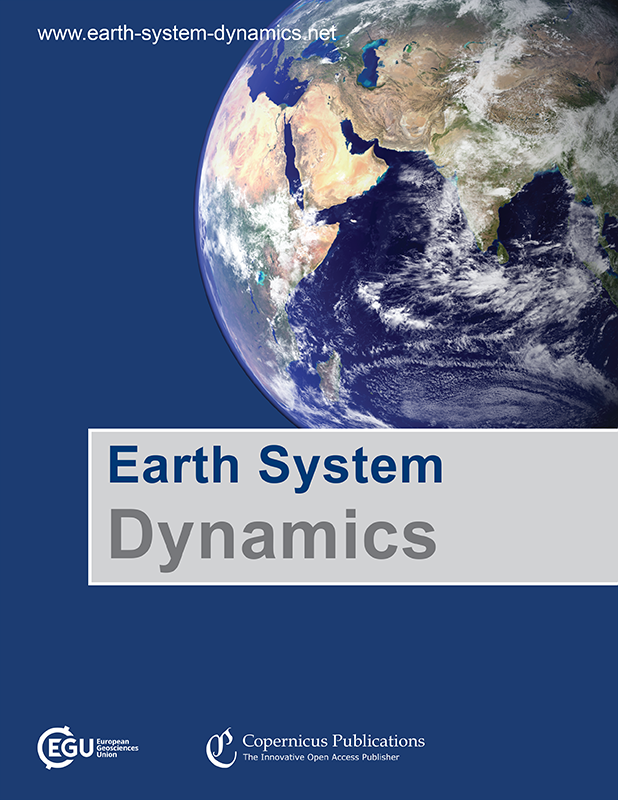The long-term impact of transgressing planetary boundaries on biophysical atmosphere–land interactions
IF 7.9
2区 地球科学
Q1 GEOSCIENCES, MULTIDISCIPLINARY
引用次数: 0
Abstract
Abstract. Human activities have had a significant impact on Earth's systems and processes, leading to a transition of Earth's state from the relatively stable Holocene epoch to the Anthropocene. The planetary boundary framework characterizes major risks of destabilization, particularly in the core dimensions of climate and biosphere change. Land system change, including deforestation and urbanization, alters ecosystems and impacts the water and energy cycle between the land surface and atmosphere, while climate change can disrupt the balance of ecosystems and impact vegetation composition and soil carbon pools. These drivers also interact with each other, further exacerbating their impacts. Earth system models have been used recently to illustrate the risks and interacting effects of transgressing selected planetary boundaries, but a detailed analysis is still missing. Here, we study the impacts of long-term transgressions of the climate and land system change boundaries on the Earth system using an Earth system model with an incorporated detailed dynamic vegetation model. In our centennial-scale simulation analysis, we find that transgressing the land system change boundary results in increases in global temperatures and aridity. Furthermore, this transgression is associated with a substantial loss of vegetation carbon, exceeding 200 Pg C, in contrast to conditions considered safe. Concurrently, the influence of climate change becomes evident as temperatures surge by 2.7–3.1 °C depending on the region. Notably, carbon dynamics are most profoundly affected within the large carbon reservoirs of the boreal permafrost areas, where carbon emissions peak at 150 Pg C. While a restoration scenario to reduce human pressure to meet the planetary boundaries of climate change and land system change proves beneficial for carbon pools and global mean temperature, a transgression of these boundaries could lead to profoundly negative effects on the Earth system and the terrestrial biosphere. Our results suggest that respecting both boundaries is essential for safeguarding Holocene-like planetary conditions that characterize a resilient Earth system and are in accordance with the goals of the Paris Climate Agreement.跨越行星边界对大气-陆地生物物理相互作用的长期影响
摘要人类活动对地球系统和进程产生了重大影响,导致地球状态从相对稳定的全新世过渡到人类世。行星边界框架描述了不稳定的主要风险,特别是在气候和生物圈变化的核心方面。包括森林砍伐和城市化在内的土地系统变化会改变生态系统,影响地表与大气之间的水和能量循环,而气候变化则会破坏生态系统的平衡,影响植被组成和土壤碳库。这些驱动因素还会相互影响,进一步加剧其影响。近来,地球系统模型已被用于说明跨越选定的地球边界所带来的风险和相互影响,但仍缺少详细的分析。在这里,我们利用一个包含详细动态植被模型的地球系统模型,研究了长期跨越气候和土地系统变化边界对地球系统的影响。在我们的百年尺度模拟分析中,我们发现跨越陆地系统变化边界会导致全球气温和干旱度上升。此外,与安全条件相比,这种越界与植被碳的大量损失有关,超过 200 Pg C。与此同时,气候变化的影响也开始显现,根据地区不同,气温会骤升 2.7-3.1 ℃。值得注意的是,在北方永久冻土区的大型碳库中,碳动态受到的影响最为严重,碳排放量达到 150 摄氏度的峰值。虽然减少人类压力以满足气候变化和陆地系统变化的地球边界的恢复方案证明对碳库和全球平均温度有利,但突破这些边界可能会对地球系统和陆地生物圈产生深远的负面影响。我们的研究结果表明,尊重这两个边界对于保护全新世的地球条件至关重要,而全新世的地球条件是弹性地球系统的特征,也符合《巴黎气候协定》的目标。
本文章由计算机程序翻译,如有差异,请以英文原文为准。
求助全文
约1分钟内获得全文
求助全文
来源期刊

Earth System Dynamics
GEOSCIENCES, MULTIDISCIPLINARY-
CiteScore
13.20
自引率
5.50%
发文量
61
审稿时长
36 weeks
期刊介绍:
Earth System Dynamics (ESD) is a not-for-profit international scientific journal committed to publishing and facilitating public discussion on interdisciplinary studies focusing on the Earth system and global change. The journal explores the intricate interactions among Earth's component systems, including the atmosphere, cryosphere, hydrosphere, oceans, pedosphere, lithosphere, and the influence of life and human activity. ESD welcomes contributions that delve into these interactions, their conceptualization, modeling, quantification, predictions of global change impacts, and their implications for Earth's habitability, humanity, and the future dynamics in the Anthropocene.
 求助内容:
求助内容: 应助结果提醒方式:
应助结果提醒方式:


